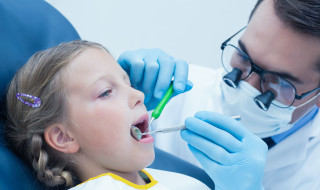 Kajal Shah says loupes can help improve poor posture.
Kajal Shah says loupes can help improve poor posture.
Loupes in dentistry help to provide enhanced visibility and thus accuracy during treatment. In addition to improving the quality of dentistry, loupes have been designed to be ergonomic and provide greater comfort to practising dentists.
One of the most common uses of loupes is for endodontic treatment. For this use a magnification of greater than 4x is recommended. The magnification allows canals to be found, accessed and mechanically prepared with far greater accuracy.
Certain canals like the mesiobuccal 2 (MB2) of upper first molars are near impossible to locate without magnification. It has been shown that the detection rates of MB2 canals increase with magnification from 17.2% with the naked eye, to 62.5% with loupes and 71.1% with a microscope (Buhrley et al, 2002). Untreated MB2 canals have been implicated in many failed root canal treatments (Wolcott et al, 2005).
Loupes are also used in other aspects of restorative dentistry. The accuracy of crown or veneer preparation is majorly improved with magnification.
Margins are clearer and imperfections are more evident and then easily corrected. Inspection of the impressions under magnification also aids overall accuracy, ensuring that preparation margins are correctly recorded.
Posture
Comfort during treatment is another ergonomic benefit of dental loupes. Loupes can help to improve poor posture, which is often a contributing factor to musculoskeletal disorders, a common complaint amongst dental professionals (www.champspublichealth.com, 2009).
Maintaining a good posture can help prevent common dental back and neck injuries, which can have financial implications and a negative impact on the quality of life of a dental professional (Valachi and Valachi, 2003).
Loupes help can help to improve and maintain good posture by having them set up to only give a clear image when the operator has an upright posture (Breslin and Cook, 2013). Loupes have been shown to also reduce eyestrain and fatigue, invaluable during lengthy precision treatments.
Magnification
Wearing loupes during a clinical examination can also be of great value. Magnification inevitably increases the chances of detecting small indistinct lesions. Microcracks, enamel demineralisation and sometimes even existing restorations are just a few things that can often go unnoticed without adequate lighting and magnification.
Earlier detection of caries and cracks can prevent catastrophic failures and pain in the future, and possibly prevent litigation following missed lesions. As always it is advised when examining teeth to ensure the surface is clean and dry before examining under good lighting and magnification.
Dentists who have been in the profession for several years will confess that their vision isn’t as good as it once was, and for them loupes may be the piece of equipment that allows them to continue to practice safely, ethically and to an overall superior standard.
Considering the above discussion it is quite clear that any dentists not using magnification are putting themselves at a great disadvantage. The resulting work will be of poorer quality and the chance of developing chronic pain injuries during your career are high.
References
Breslin M and Cook S (2013) No turning back: posture in dental practice. Vital 10: 23-25.
Buhrley LJ, Barrows MJ, BeGole EA, Wenckus CS (2002) Effect of magnification on locating the MB2 canal in maxillary molars. J Endod 28(4): 324-327.
Valachi B, Valachi K (2003) Preventing musculoskeletal disorders in clinical dentistry: strategies to address the mechanisms leading to musculoskeletal disorders. J Am Dent Assoc 134(12): 1604-1612.
Wolcott J, Ishley D, Kennedy W, Johnson S, Minnich S, Meyers J (2005) A 5 yr clinical investigation of second mesiobuccal canals in endodontically treated and retreated maxillary molars. J Endod 31(4): 262-264.
http://www.champspublichealth.com/writedir/ee61A%20Systematic%20Review%20of%20the%20Health%20of%20Health%20Practitioners%20-%20June%202009.pdf retrieved 16/2/16
Kajal studied dentistry and graduated in 2013. Since then she has completed her foundation training year in general practice and furthered her training in oral and maxillofacial surgery at the Royal Surrey County Hospital. Kajal has also completed the Membership of the Faculty of Dental Surgery, a postgraduate diploma in primary dental care and is qualified in basic and advanced facial aesthetics. Kajal works as a general dental practitioner.


